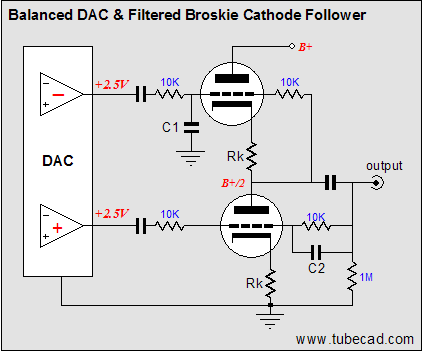John Broskie over at www.tubecad.com has a lot of interesting ideas.
One of them involves using a special version of the cathode follower as a balanced to single ended unity gain stage for a dac (like eg. the Wolfson Vout dacs).
I am trying to figure out the correct values for the Rk and B+ in circuit below when using the Russian 6N6P tubes.
Typical values for this tube are:
Ua = 120V
Ia = 30 mA
Ug = -2V
Is the Rk calculation as simple as:
2V/30ma = 66.67 ohm, and are they identical in value?
And the B+:
120V+2V *2 = 244V ?
I suppose that it is not this simple!
And will I have to lift the heaters of the upper tube (as you normally would in a high voltage SRPP stage)?

One of them involves using a special version of the cathode follower as a balanced to single ended unity gain stage for a dac (like eg. the Wolfson Vout dacs).
I am trying to figure out the correct values for the Rk and B+ in circuit below when using the Russian 6N6P tubes.
Typical values for this tube are:
Ua = 120V
Ia = 30 mA
Ug = -2V
Is the Rk calculation as simple as:
2V/30ma = 66.67 ohm, and are they identical in value?
And the B+:
120V+2V *2 = 244V ?
I suppose that it is not this simple!

And will I have to lift the heaters of the upper tube (as you normally would in a high voltage SRPP stage)?

Hello !
As I can remember a discussion with a dyer, about these tubes on Aikido, his advice was 200-240v, with Rp=Rk, about 390 to 420 Ohms (never tried by myself)
I built something similar, but with a low B+, and 6gm8 tubes : B+= 24v and Rp=Rk=180 Ohms. The advantage is that you manage heater and B+ with 2 lm317 (2 slow turn-on PSU on a 5x4" board)
My Dac is a cheap board, with CS8416/cs4397 , with Dale resistors and blue Elna Caps, (added some Oscon and solid tantalum), bought on Ebay ~80$...Now sounds terriffic !!!(not yet boxed, too much pleasure to listen to )
Hope this help !
R.C.
As I can remember a discussion with a dyer, about these tubes on Aikido, his advice was 200-240v, with Rp=Rk, about 390 to 420 Ohms (never tried by myself)
I built something similar, but with a low B+, and 6gm8 tubes : B+= 24v and Rp=Rk=180 Ohms. The advantage is that you manage heater and B+ with 2 lm317 (2 slow turn-on PSU on a 5x4" board)
My Dac is a cheap board, with CS8416/cs4397 , with Dale resistors and blue Elna Caps, (added some Oscon and solid tantalum), bought on Ebay ~80$...Now sounds terriffic !!!(not yet boxed, too much pleasure to listen to )
Hope this help !
R.C.
Thanks a lot, CIU!
That gives me some ballpark values to start with.
Actually I have some 6gm8 tubes I could try out as well.🙂
That gives me some ballpark values to start with.
Actually I have some 6gm8 tubes I could try out as well.🙂
I too have one of the eBay CS8416/cs4397 board lying around, and thinking to make a integrated headphone amp.
I have been thinking along the line of a 6n6p differential input. Does the CF stage have any advantage over a differential one?
I have been thinking along the line of a 6n6p differential input. Does the CF stage have any advantage over a differential one?
Hello !
The Broskie Cathode follower, schematic as above, is a buffer, used in an output balanced voltage DAC (ie : cs4397,cs4398, opus 874x, etc...) .
The gain is near 1, the output Z depends on tube you would use
The main advantage is to cancel DAC noise, and give an unbalanced output from balanced DAC...
Don't mismatch with an Aikido !!!
R.C.
The Broskie Cathode follower, schematic as above, is a buffer, used in an output balanced voltage DAC (ie : cs4397,cs4398, opus 874x, etc...) .
The gain is near 1, the output Z depends on tube you would use
The main advantage is to cancel DAC noise, and give an unbalanced output from balanced DAC...
Don't mismatch with an Aikido !!!
R.C.
- Status
- Not open for further replies.